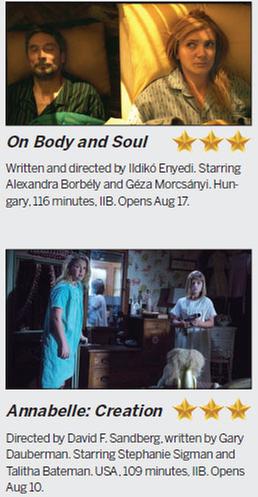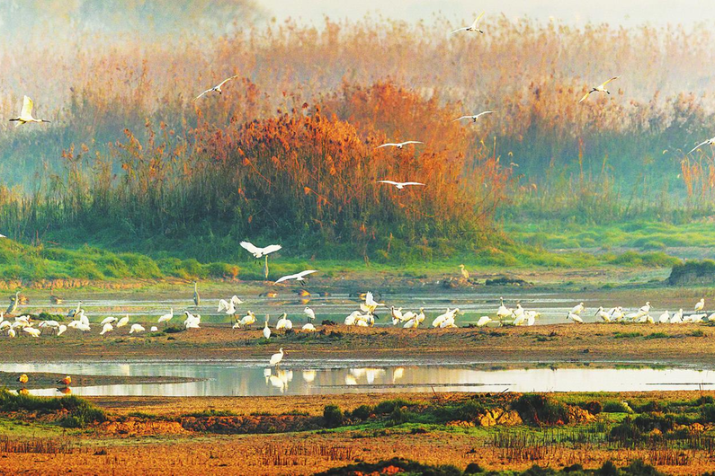Strange summer of cinematic discontent

It's been a strange summer. Coming into the home stretch, the numbers seem to say "sure things" aren't so sure (clearly we've had enough Pirates of the Caribbean and Transformers), girls can - gasp - succeed (Atomic Blonde, Wonder Woman) despite what boardroom suits think, and Marvel is getting lazy. Late August is a traditional dumping ground for wayward, unmarketable films, and as such has become a hotbed of pleasant cinematic surprise.
This year's Golden Bear winner at Berlin, On Body and Soul, comes from the same school of unconventional romance as Last Life in the Universe, Lars and the Real Girl and The Lobster. The film opens on two deer - a doe and a buck - wandering a wintery forest; silent, separated from the world, but attached to each other. The next images come from a simultaneously pristine and bloody slaughterhouse, where the retiring, resigned Endre (Gza Morcsnyi) works as finance director. Starting that day is the plant's new quality inspector, the icy, distant, and rigid Mria (Alexandra Borbly), who does nothing to endear herself to her coworkers. When a random break-in and police investigation leads to psychiatric evaluations for all staff, the significance of the deer in the forest is revealed. Endre and Mria are sharing the same recurring dream, and it unites them in a tremulous, cautious romance.
On Body and Soul tells a story as old as the movies: One about two damaged introverts ever so tentatively making an attempt at the kind of human connection they've long given up on but nonetheless desperately crave. But like Shakespeare, old stories are all in the telling - and in this case performance. Morcsnyi and Borbly, whose film it really is, turn in finely calibrated, economical performances that keep writer-director Ildik Enyedi's mawkish instincts from getting out of control. A slyly life-affirming film, On Body and Soul is carefully poised on the razor's edge of emotion, complemented by monochromatic visuals and an empathetic, melancholy Borbly who carries the day.
The latest entry into the burgeoning Conjuring franchise, Annabelle: Creation is the follow-up (in practice a prequel) to the creepy doll spin-off from James Wan's surprise 2013 hit, The Conjuring. The first entry, Annabelle, was an execrable example of cynical, clinical filmmaking that relied on the silliest of horror tropes with zero thought to creative execution. Thankfully this time, David F. Sandberg steps behind the camera to a much better effect. Sandberg made his debut with accomplished if unremarkable Lights Out, and here he doubles down on moody cinematography, deliberately layered tension and old-school atmospherics, all but guaranteeing a third installment.
In what appears to be the mid-1950s, toymaker Sam Mullins and his wife Esther (Anthony LaPaglia, Miranda Otto) open their sprawling desert home to Sister Charlotte (Stephanie Sigman) and six orphaned girls in her charge. The youngest, the polio-stricken Janice (Talitha Bateman) and her best friend Linda (Lulu Wilson), are immediately banished to the little girls' room, and feeling isolated already, Janice starts exploring the labyrinthine house and its various crawlspaces. Eventually she makes her way into the room that belonged to Mullins' deceased daughter. Cue demonic hi-jinks.
Compared with the understated On Body and Soul, Annabelle: Creation is a mess of outr emotion and cranium-pounding telegraphing, but each film is effective in its own way; both know exactly what they're out to accomplish, and do so with aplomb. Neither is perfect: Creation leans heavily on by-the-numbers horror convention, and is saved by an endearingly plucky central duo, particularly Wilson as the devoted, resourceful buddy. Body is a bit of an oddity as Berlin winners go, and on first glance seems a curious selection. After sagging in the second act and some tonal incongruity, once it's left to simmer for a while, a bittersweet love story emerges from the murky forest where much of the film is set. It could be called a dark feel-good movie - quite appropriate for one of the oddest summers in moviedom in recent memory.

(HK Edition 08/11/2017 page9)
Today's Top News
- Hainan FTP launches intl services portal
- HK's Jimmy Lai convicted in national security case
- China announces countermeasures against former Japanese senior official
- Australia set to further tighten gun control laws
- HKSAR security chief on conviction of Jimmy Lai
- Jimmy Lai's verdict sends clear messages






























